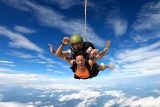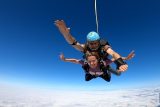Can You Talk While Skydiving?
Blog
 Posted by: Curtis White
8 months ago
Posted by: Curtis White
8 months ago
We’ve all seen the action movies where the hero and villain engage in some sort of high-flying, high-stakes antics mid-freefall, taunting and goading each other while plummeting toward the earth. We also all know that what you see in the movies isn’t necessarily possible in reality. So that begs the question, can you talk while skydiving? And, even if you can talk, can you hear people while skydiving?
The answers to these questions are more complicated than a simple yes or no. Every skydive is made up of different phases, and each phase is a completely unique experience. A lot of factors go into whether or not you can communicate in the sky.
There are a variety of sensations, emotions, and feelings that come with jumping out of an airplane. Let’s dig into the ‘if’ and ‘how’ of talking while skydiving.
Talking in Freefall
The most common place that popular culture depicts sky conversations is in freefall. The urgency, the rush, the danger … it all makes for a very compelling scenario. But in real life, freefall is the last place you would be able to carry on a conversation!
Technically, you can speak in freefall. Talking isn’t the issue. It’s other people hearing you that’s a problem. The 120 mph wind whipping by your ears acts as a highly effective noise-canceling device. Some crazy stuff also happens to the soundwaves when they leave your mouth while you’re traveling that fast (see: Doppler effect).
Between the windy earmuffs and the distortion of sound, there’s no chance anyone’s going to be having a back-and-forth in the middle of freefall. As cool as it looks on screen, it’s actually a bit silly in real life.
Bonus fact: Can you breathe through your mouth while skydiving? Yes! In fact “talking” (aka screaming) in freefall can actually help you catch your breath if you’re overwhelmed by the sensations of freefall. Pushing the air out of your lungs will help jump-start your breathing cycle and get things moving again. And the best part? No one can hear what you’re saying, no matter how loudly you say it!
Talking Under Canopy
Just because you can’t communicate during the freefall portion of the skydive doesn’t mean you won’t be able to have a conversation the entire time you’re in the air. As you probably already know, the parachute is designed to slow your fall significantly. You’ll actually slow down by about 100 mph when the parachute opens!

And with this slow down comes quieter surroundings. Moving through the air under canopy feels about the same as going for a walk on a 20 mph wind day. And while 20 mph wind would still be considered quite blustery, it’s certainly not like the hurricane-level, deafening winds of freefall!
That means that you can easily carry on a full conversation with your tandem instructor the entire time you’re flying your parachute. Feel free to share or ask anything you want! You can tell about how you’re feeling (it never gets old!) and about your inspiration for jumping, learn more about skydiving and ask specific questions and, of course, get a birds-eye-view tour of the area surrounding the dropzone.
We love sharing the sky with you and hearing about what lights your fire!
How Loud is Skydiving?
We’re going to focus on the freefall portion of the jump to answer this question since we already established that it’s not very loud once the parachute is open.
If you’re someone who likes numbers and science, the answer is pretty simple. The sound of freefall is about 115 decibels. That’s a similar level of noise to a bulldozer, a motorcycle, or a good rock concert. And it’s only 5 decibels below a chainsaw or 15 decibels lower than a military jet taking off. For a more relatable real-life comparison, normal conversation usually comes in at about 60 decibels.
For those who have a hard time gauging comparisons (or being able to translate decibels), we’re with you. A more casual way of describing the sound of freefall is like a white noise machine plugged into an amplifier. It’s not loud enough to cause pain in your ears, but it is loud enough that that’s the only thing you’ll be able to hear.
Technically speaking, you’d need to be exposed to the noise levels of freefall for two to five continuous minutes before there would be any damage to your hearing, which is several times longer than you spend in freefall on a standard tandem jump. Even a high-altitude tandem from 18,000 feet caps at about 90 seconds of freefall.
Other Ways of Communicating
Because of how difficult it is to communicate verbally while skydiving, an official set of hand signals has been developed to assist in training new skydivers. These hand signals are universal across the sport of skydiving and are used to communicate important messages an instructor might need to get across to a student.
A few of these signals include:
- Thumbs up: Doing great, keep doing what you’re doing!
- Thumbs down: Arch harder
- Pointer finger: Pull your parachute
- A circle with the fingers and thumb: Check your altitude
Skydivers can also use other predetermined hand signals that they invent themselves to communicate with friends or teammates in the air. And certain hand signals carry over from student training to experienced skydiver language. There’s no reason to reinvent the wheel!

Some skydivers even install remote communication devices in their helmets to talk to each other during their jumps. These are mainly used to communicate with other people in the sky while under the parachute and can be extremely helpful when training for certifications or competitions.
As far as tandem skydives go, getting a video package is a great way to communicate with everyone in your life during your experience! You can show them the video of how amazing your jump was, they can see the excitement in your face, and you can even write words on your hands for them to read.
Speaking of videos and communicating … Can you hold your phone while skydiving? Phones would make a nice all-in-one device to use during your jump, no? No.
The rules and regulations of skydiving state that no student skydiver is allowed to take a camera, including a phone, on a jump. And, furthermore, do you really trust yourself to hang onto that expensive and slippery gadget in 120 mph wind?? It’s best to leave the communicating and capturing to the pros and their tried and true methods so that you can focus on enjoying your skydive.
Are you ready to have an experience you can’t stop talking about?? Book your jump today and see what all the fuss is about! Blue skies.
Categories:
You May Be Interested In:
Enter to Win a Free Skydive
Join our email list and enter to win a free tandem skydive. Drawings in April and December; winner announced on social media.
You’ll get a $10 coupon toward a tandem just for signing up! Must be 18 and under 240 lbs to jump.
*By submitting this form, you are consenting to receive marketing emails from Skydive New England, 40 Skydive Lane, Lebanon, Maine 04027. You can revoke your consent by using the SafeUnsubscribe link located at the bottom of every email. Emails are serviced by Constant Contact.


Even More Wicked-Fun Than It Looks!
Come see why the biggest DZ in New England is also the best.




